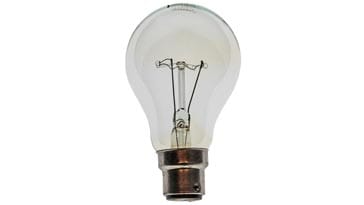what happens to the resistance of a light bulb as the filament heats?
Resistance of a Filament Lamp: why is it Not-Ohmic
The resistance of a filament lamp or seedling changes with the temperature of the filament as the potential across it increases and this means it is not-Ohmic.
Resistance Tutorial Includes:
What is resistance Ohms Law Ohmic & Non-Ohmic conductors Resistance of filament lamp Resistivity Resistivity table for common materials Resistance temperature coefficient Electrical electrical conductivity Series & parallel resistors Parallel resistors table
Agreement the resistance of a filament lamp or bulb and why information technology changes gives insights into a variety of electrical and electronic components that are classed as non-Ohmic.
Knowing whether items are Ohmic or non-Ohmic can play a large part in electric and electronic circuit design and understanding the reasons for these properties can give more insight into their performance.
Incandescent or filament lamps are a key example of an electrical or electronic component that is non-Ohmic. Agreement why these filament lamps are not-Ohmic enables them to be used more appropriately.

What is a non-Ohmic usher
Before looking a little more closely at incandescent lamps or filament lamps and why they are non-Ohmic, it is worth recapping what a non-Ohmic usher is.
Essentially a non-Ohmic conductor or component is one that does not follow Ohms law. In other words if the voltage is doubled the electric current volition not double.
In other words there is non a linear relationship between the voltage and current and a graph of the current and voltage would not be a direct line.
What are filament lamps / incandescent lamps
The incandescent lite bulb is a prime number example of a non-ohmic conductor, and they are used to demonstrate the non-Ohmic response in many experiments.
Filament lamps, too called incandescent lamps, are not widely used these days because they are very inefficient in terms of their conversion of electric energy to calorie-free free energy. Typically they convert less than five% or the power entering them into light. The rest is dissipated as heat. With modern LED lamps beingness as much equally 85% efficient, LEDs offer a far better option for lighting.
The filament lamp consists of a coiled wire filament held on posts inside a glass bulb. The filament is normally very thin and as a consequence it is able to offering a reasonable level of resistance. In turn this ways that with a potential difference practical and current flowing though it, heat will be disipated.
The level of estrus prodigal within the filament, raises the temperature significantly, and the filament glows white hot - this is what generates the light that is emitted.
Cheque out our video about the Resistance of a Filament Lamp
Why a filament lamp is non-Ohmic
The reason for the non-Ohmic feature results from the heat generated past the filament of the lamp.
For normal functioning a lamp will be powered past a bombardment as in the case of a torch, or from the mains power lines for domestic or industrial lighting.
These ability sources provide an nearly constant voltage and it can be causeless this remains the same all of the time.
When first turned on, the lamp has a depression resistance: a domestic lighting lamp will have a resistance of a few Ohms. As a upshot there volition be a large inrush of current.
This means that the filament becomes very hot, very quickly - it is heated to white heat.
However with the increase in temperature, the resistance likewise rises and so that the current reduces and the lamp settles to normal operation.
If the I V feature was to be measured and plotted for various voltages, then it would exist found that for depression voltages the resistance would exist depression and the current would be high for the voltage applied. Equally the potential departure across a filament lamp is increased, the current increases and the energy prodigal, every bit oestrus, increases, resulting in a filament operating at a college temperature. As the temperature increases, resistance of the filament besides increases.

Note that the graph of the resistance of the filament lamp has both positive and negative elements to it. This is because the voltage tin can be applied in either sense and the same performance will be seen.
As the filament within an incandescent lamp heats up, there is a meaning modify in the resistance betwixt the off land and when it is operating. A typical 60W bulb operating at 250 volts will consume 0.24 amps and accept a resistance of 1041Ω or thereabouts. When measured using a digital multimeter the resistance is just a few Ohms because the filament will be cold.
The reason for this change is that when the filament is operating at room temperature with only a small potential difference applied, the electrons are able to menstruum through it relatively easily. They take sufficient free energy to be drawn through the filament wire.
However, when the filament is at its operating temperature, the electrons have a large amount of energy as a result of the very high temperature. This means that they are unable to flow through the lattice int he wire smoothly and hence their flow is impeded, and the resistance to the current flow is significantly increased.
A filament lamp or incandescent low-cal seedling provides an splendid example of a non-Ohmic component. Its resistance is low for low potential differences and it rises equally the voltage increases and the temperature of the filament rises.
More Basic Electronics Concepts & Tutorials:
Voltage Current Power Resistance Capacitance Inductance Transformers Decibel, dB Kirchoff's Laws Q, quality factor RF noise Waveforms
Render to Bones Electronics Concepts carte du jour . . .
cabralessuplined1987.blogspot.com
Source: https://www.electronics-notes.com/articles/basic_concepts/resistance/why-is-filament-incandescent-lamp-nonohmic.php
0 Response to "what happens to the resistance of a light bulb as the filament heats?"
Publicar un comentario